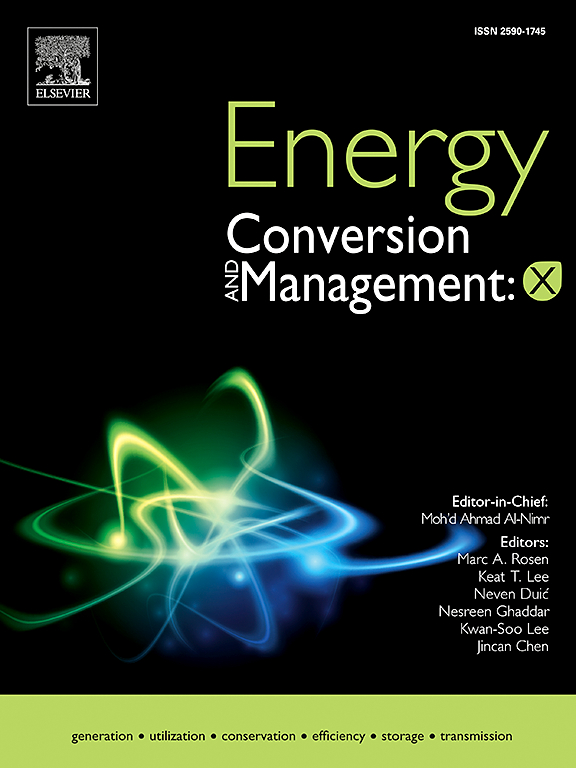Sustainable design and control of a multi-sourced radiant heating system: Non-linear optimization under thermal comfort constraints
IF 9.9
1区 工程技术
Q1 ENERGY & FUELS
引用次数: 0
Abstract
The demand for energy-efficient heating solutions in buildings is increasing consistently, necessitating tools to determine the system’s optimal design and operation, while ensuring occupant comfort. This study develops a novel thermal comfort-constrained capacity-operation optimization framework for a multi-source (solar collectors, a biomass boiler, and a gas boiler) radiant floor heating system, addressing the limitations of existing literature that typically focus on non-linear optimization of single-source systems. The system incorporates two forms of thermal storage, namely a water tank and a thermally active floor slab, which magnifies the system’s non-linearities. Hence, a non-linear interior-point optimization algorithm (Ipopt) is implemented in MATLAB® to minimize lifecycle costs (LCC). Unlike conventional approaches, the developed optimization framework has three novel features: i) it captures the dynamics and complex interactions between heat generation, storage, and consumption components, ii) it constrains temperature levels to ensure energy quality while simultaneously solving thermal comfort equations at each time step, accounting for the dynamic response of the building in subsequent steps, and iii) it balances various operational and sizing decision variables, capturing the bi-directional impacts of optimal system capacity and management. The results reveal that the tri-source system achieves an LCC of approximately 0.42 mil. CAD (Canadian dollars), equivalent to 0.3 mil. USD, and a competitive levelized cost of heat (LCOH) of 0.143 CAD kWh多源辐射供暖系统的可持续设计与控制:热舒适约束下的非线性优化
建筑中对节能供暖解决方案的需求不断增加,需要工具来确定系统的最佳设计和运行,同时确保居住者的舒适度。本研究为多源(太阳能集热器、生物质锅炉和燃气锅炉)地板辐射供暖系统开发了一种新的热舒适约束的容量运行优化框架,解决了现有文献通常关注单源系统非线性优化的局限性。该系统包含两种形式的储热,即水箱和热活动底板,这放大了系统的非线性。因此,在MATLAB®中实现了非线性内点优化算法(Ipopt),以最小化生命周期成本(LCC)。与传统方法不同,开发的优化框架有三个新特点:1)它捕捉热产生、储存和消耗组件之间的动态和复杂的相互作用;2)它限制温度水平以确保能源质量,同时在每个时间步解热舒适方程,在后续步骤中考虑建筑物的动态响应;3)它平衡各种操作和规模决策变量,捕捉最佳系统容量和管理的双向影响。结果表明,三源系统的LCC约为0.42百万加元(相当于30万美元),具有竞争力的平均热成本(LCOH)为0.143加元千瓦时−1(0.1美元千瓦时−1),在19°C至25°C之间保持稳定的工作温度,平均预测平均投票(PMV)为- 0.12,总生命周期二氧化碳排放量为330.15吨。与简单的设计变化进行对比分析表明,纯气系统的LCC最低,为0.302亿加元(0.21亿美元),但其排放量几乎是三源系统的两倍。在可再生能源选择中,太阳能-生物质系统提供了经济(LCC为506万加元或0.36万美元)、环境(110.9吨二氧化碳)和舒适指标(平均PMV为- 0.12)的最佳平衡。
本文章由计算机程序翻译,如有差异,请以英文原文为准。
求助全文
约1分钟内获得全文
求助全文
来源期刊

Energy Conversion and Management
工程技术-力学
CiteScore
19.00
自引率
11.50%
发文量
1304
审稿时长
17 days
期刊介绍:
The journal Energy Conversion and Management provides a forum for publishing original contributions and comprehensive technical review articles of interdisciplinary and original research on all important energy topics.
The topics considered include energy generation, utilization, conversion, storage, transmission, conservation, management and sustainability. These topics typically involve various types of energy such as mechanical, thermal, nuclear, chemical, electromagnetic, magnetic and electric. These energy types cover all known energy resources, including renewable resources (e.g., solar, bio, hydro, wind, geothermal and ocean energy), fossil fuels and nuclear resources.
 求助内容:
求助内容: 应助结果提醒方式:
应助结果提醒方式:


